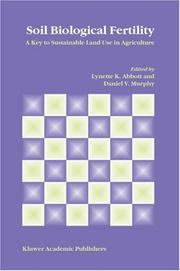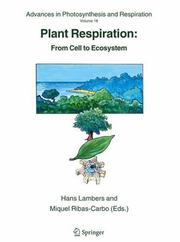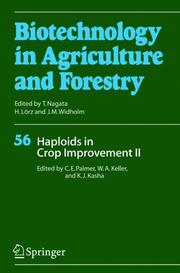| Listing 1 - 10 of 21 | << page >> |
Sort by
|
Book
ISBN: 1281138142 9786611138141 1402062958 140206294X 9048175992 9781402062957 Year: 2007 Publisher: Dordrecht : Springer Netherlands : Imprint: Springer,
Abstract | Keywords | Export | Availability | Bookmark
 Loading...
Loading...Choose an application
- Reference Manager
- EndNote
- RefWorks (Direct export to RefWorks)
Genomics research has great potential to revolutionize the discipline of plant breeding. This two-volume set provides a critical assessment of genomics tools and approaches for crop breeding. Volume 1, entitled "Genomics Approaches and Platforms", illustrates state-of-the-art genomics approaches and platforms presently available for crop improvement. Volume 2, entitled "Genomics Applications in Crops", compiles crop-specific studies that summarize both the achievements and limitations of genomics research for crop improvement. We hope that these two volumes, while providing new ideas and opportunities to those working in crop breeding, will help graduate students and teachers to develop a better understanding of the applications of crop genomics to plant research and breeding.
Crops --- Crop improvement. --- Genetic engineering. --- Improvement, Crop --- Agriculture --- Plant genetic engineering --- Improvement --- Agriculture. --- Botany. --- Plant genetics. --- Biotechnology. --- Plant Sciences. --- Plant Genetics and Genomics. --- Plants --- Genetics --- Chemical engineering --- Genetic engineering --- Botanical science --- Phytobiology --- Phytography --- Phytology --- Plant biology --- Plant science --- Biology --- Natural history --- Farming --- Husbandry --- Industrial arts --- Life sciences --- Food supply --- Land use, Rural --- Plant science. --- Floristic botany

ISBN: 3540411399 3642563597 Year: 2001 Publisher: New York, NY ; Berlin : Springer-Verlag,
Abstract | Keywords | Export | Availability | Bookmark
 Loading...
Loading...Choose an application
- Reference Manager
- EndNote
- RefWorks (Direct export to RefWorks)
As an intricate association between a fungus and one or more green algae or cyanobacteria, lichens are one of the most successful examples of symbiosis. These fascinating organisms survive extreme desiccation and temperatures. They are adapted to a great variety of habitats, from coastal fog zones of deserts to intertidal zones, from plant leaves in tropical rain forests to the glacial moraines of the Himalayas, and they are dominant components of communities in circumpolar ecosystems. Possibly, because of their tendency to grow in nutrient-poor habitats, lichens are extremely efficient accumulators of atmospherically deposited pollutants, and are therefore widely used to monitor environmental pollution. The wide range of secondary products only found in lichens show pharmaceutically interesting fungicidal, antibacterial and antiviral properties. Lichens are extremely difficult to culture, grow very slowly, and their secondary metabolites very often complicate the analyses of other compounds. As a result, they require special techniques. This manual provides well-tested protocols, including tissue culture protocols and methods for studying lichen ultrastructure, (eco)physiology, primary and secondary compounds, and nucleic acids. Protocols for using lichens to monitor environmental pollution and to document lichen biodiversity are also provided. Special terms used in lichenology are explained in a glossary.
Lichenology --- Mossen --- Korstmossen --- Plant science. --- Botany. --- Biotechnology. --- Ecotoxicology. --- Ecology . --- Plant Sciences. --- Ecology. --- Balance of nature --- Biology --- Bionomics --- Ecological processes --- Ecological science --- Ecological sciences --- Environment --- Environmental biology --- Oecology --- Environmental sciences --- Population biology --- Ecotoxicology --- Pollutants --- Pollution --- Environmental health --- Toxicology --- Chemical engineering --- Genetic engineering --- Botanical science --- Phytobiology --- Phytography --- Phytology --- Plant biology --- Plant science --- Natural history --- Plants --- Ecology --- Floristic botany --- LICHENOLOGY --- LABORATORY MANUALS
Book
ISBN: 9780387755311 9780387755328 0387755314 1489991328 9786611926960 1281926965 0387755322 Year: 2007 Publisher: New York : Austin : Springer Science+Business Media, LLC Landes Bioscience,
Abstract | Keywords | Export | Availability | Bookmark
 Loading...
Loading...Choose an application
- Reference Manager
- EndNote
- RefWorks (Direct export to RefWorks)
Microalgae have been largely cultured and commercialized as food and feed additives, and their potential as source of high-added value compounds is well known. But, in contrast to the large number of genetically modified bacteria, yeast and even higher plants, only a few species of microalgae have been genetically transformed with efficiency. Initial difficulties in the expression of foreign genes in microalgae have been progressively overcome, and powerful molecular tools for their genetic engineering are now on hand. A considerable collection of promoters and selectable marker genes and an increasing number of genomic or cDNA sequences have become available in recent years. More work is needed to transform new species of microalgae, specially those that have commercial value, so that it would be possible to increase the productivity of traditional compounds or synthesize novel ones. Silencing transgenes remains as an important limitation for stable expression of foreign genes. This problem is not unique to microalgae since it has also been observed in plants, animals and fungi. A better understanding of the mechanisms that control the regulation of gene expression in eukaryotes is therefore needed. In this book a group of outstanding researchers working on different areas of microalgae biotechnology offer a global vision of the genetic manipulation of microalgae and their applications.
Algae --- Biological Factors --- Bioreactors. --- Biotechnology --- Genetic transformation. --- Microalgae --- Transformation, Genetic. --- physiology. --- biosynthesis. --- methods. --- Biotechnology. --- Physiology. --- Plant science. --- Botany. --- Cell biology. --- Microbial ecology. --- Plant Sciences. --- Cell Biology. --- Microbial Ecology. --- Environmental microbiology --- Microorganisms --- Ecology --- Microbiology --- Botanical science --- Floristic botany --- Phytobiology --- Phytography --- Phytology --- Plant biology --- Plant science --- Biology --- Natural history --- Plants --- Cell biology --- Cellular biology --- Cells --- Physiology

ISBN: 1402017561 9781402066191 140206618X 9781402066184 1402066198 Year: 2007 Publisher: Dordrecht : Springer Netherlands : Imprint: Springer,
Abstract | Keywords | Export | Availability | Bookmark
 Loading...
Loading...Choose an application
- Reference Manager
- EndNote
- RefWorks (Direct export to RefWorks)
This book presents a comprehensive scientific overview of the components and processes that underpin the biological characteristics of soil fertility. It demonstrates the interdependence of soil biological fertility with physical and chemical characteristics of soil. The book highlights the enormous diversity of life in soil and the resulting effects that management of land can have on the contribution of this diverse community to soil fertility in an agricultural context. It is becoming more relevant to explore soil biological processes in terms of their contribution to soil fertility.
Soil biology. --- Soil fertility. --- Land use. --- Sustainable agriculture. --- Sols --- Utilisation du sol --- Agriculture durable --- Biologie --- Fertilité --- Environment. --- Soil Science & Conservation. --- Soil conservation. --- Plant science. --- Botany. --- Soil science. --- Plant Sciences. --- Low-input agriculture --- Low-input sustainable agriculture --- Lower input agriculture --- Resource-efficient agriculture --- Sustainable farming --- Agriculture --- Alternative agriculture --- Soils --- Fallowing --- Fertilizers --- Soil productivity --- Biology --- Natural history --- Land --- Land utilization --- Use of land --- Utilization of land --- Economics --- Land cover --- Landscape assessment --- NIMBY syndrome --- Fertilization --- Fertilizer movement --- Conservation of soil --- Erosion control, Soil --- Soil erosion --- Soil erosion control --- Agricultural conservation --- Soil management --- Botanical science --- Phytobiology --- Phytography --- Phytology --- Plant biology --- Plant science --- Plants --- Control --- Prevention --- Conservation --- Pedology (Soil science) --- Earth sciences --- Floristic botany --- Soil Science. --- Plant Science.

ISBN: 1280283971 9786610283972 1402035896 1402035888 9781402035883 9781402035890 9048169038 Year: 2005 Publisher: Dordrecht : Springer Netherlands : Imprint: Springer,
Abstract | Keywords | Export | Availability | Bookmark
 Loading...
Loading...Choose an application
- Reference Manager
- EndNote
- RefWorks (Direct export to RefWorks)
Respiration in plants, as in all living organisms, is essential to provide metabolic energy and carbon skeletons for growth and maintenance. As such, respiration is an essential component of a plant’s carbon budget. Depending on species and environmental conditions, it consumes 25-75% of all the carbohydrates produced in photosynthesis – even more at extremely slow growth rates. Respiration in plants can also proceed in a manner that produces neither metabolic energy nor carbon skeletons, but heat. This type of respiration involves the cyanide-resistant, alternative oxidase; it is unique to plants, and resides in the mitochondria. The activity of this alternative pathway can be measured based on a difference in fractionation of oxygen isotopes between the cytochrome and the alternative oxidase. Heat production is important in some flowers to attract pollinators; however, the alternative oxidase also plays a major role in leaves and roots of most plants. A common thread throughout this volume is to link respiration, including alternative oxidase activity, to plant functioning in different environments.
Plants --- Plant physiology. --- Botany --- Physiology --- Respiration. --- Plant respiration --- Plant physiology --- Respiration --- Gases from plants --- Effect of anaerobiosis on --- Cell Respiration. --- Ecology. --- Plant and Crop Sciences. Botany --- Plant Ecology. --- Metabolism. --- Botany. --- Agriculture. --- Science --- Plant Sciences. --- Plant Physiology. --- Science Education. --- Study and teaching. --- Science education --- Scientific education --- Ecology --- Botanical science --- Phytobiology --- Phytography --- Phytology --- Plant biology --- Plant science --- Biology --- Natural history --- Farming --- Husbandry --- Industrial arts --- Life sciences --- Food supply --- Land use, Rural --- Phytoecology --- Vegetation ecology --- Plant science. --- Plant ecology. --- Science education. --- Floristic botany --- Floristic ecology
Book
ISBN: 1489994483 0387774904 9780387774909 9780387774916 9786612363535 1282363530 0387774912 Year: 2009 Publisher: New York, NY : Springer New York : Imprint: Springer,
Abstract | Keywords | Export | Availability | Bookmark
 Loading...
Loading...Choose an application
- Reference Manager
- EndNote
- RefWorks (Direct export to RefWorks)
Genomics of the Rosaceae Edited by Kevin M. Folta and Susan E. Gardiner Plant Genetics and Genomics: Crops and Models book series provides current overviews and summaries of the state of the art in genetics and genomics for each of the important crop plants and genetic models for which such a volume does not now exist or is out of date. Volumes will focus on a single crop, species, or group of close relatives, including especially those plants that already have advanced genomic resources developed and preferably complete or advancing genome sequences. The Rosaceae Family includes many significant fruit, nut, ornamental and wood crops. Traditionally their large stature, long juvenility periods, and often complicated genomes presented little opportunity for genetic or genomic inquiry. But the new millennium brings with it new challenges to production of the highly desirable products from this family, challenges that genetic and genomic tools may help resolve. Together necessity and scientific curiosity conspire to launch deep exploration of rosaceous crop biology. This volume originates at an acceleration point for Roscaeae genomics. A foundation of outstanding tools has been developed in a cross-section of species. The successes and failures of various approaches have been documented from model systems and inform our attack on questions within the valued crops within the Rosaceae. The text within describes the species and products of this plant family along with a synopsis of the current state of research presented from experts active on the front line of Rosaceae genomics research. Kevin M. Folta is a native of Chicago, Illinois USA. Kevin completed his Ph.D. work in identification of blue light regulated promoter elements and post-transcriptional light-regulated mRNA stability at the University of Illinois at Chicago. Postdoctoral work at the University of Wisconsin centered on light regulated electrophysiology, gene expression and high-resolution growth monitoring. Kevin has maintained a unique research program in photomorphogenesis and a separate emphasis in strawberry genomics at the University of Florida in Gainesville, FL. He is active in public science education and has won awards for dedication to undergraduate research. Susan E. Gardiner grew up on a sheep farm in Christchurch, New Zealand. Home schooled as a child, Sue later obtained both her undergraduate degree and PhD in Biochemistry from Otago University in Dunedin, New Zealand. Her post-doctoral period was spent in Freiburg, Germany, where she worked to elucidate the mechanism of differential regulation of the enzymes of phenylpropanoid biosynthesis in a parsley cell culture system irradiated with UV light. In 1980, Sue joined the Plant Physiology Division of the Department of Scientific and Industrial Research (DSIR) in Palmerston North, New Zealand where she first worked on the elucidation of chloroplast glycerolipid biosynthesis and later developed techniques for distinguishing varieties of pasture grasses and legumes. Sue’s work on gene mapping in apple began in 1990 at DSIR and continued when DSIR was restructured into HortResearch in 1992. Today, Sue leads a team working to unravel the genetic architecture of traits of fruit crops central to New Zealand fruit industries. Technological advancements in Genomics at HortResearch proved to be critical in her success in identification of ‘breeder-friendly markers for traits of economic value.’ Sue has developed an extensive network of international collaborators in Rosaceae genomics, and recently completed a 2-year term as Chair of the International Rosaceae Genomics Initiative. Sue derives her greatest satisfaction from seeing her team’s marker technologies being used by breeders.
Genomics. --- Plant genomes. --- Rosaceae --Genetics. --- Rosaceae --- Genomics --- Plant genomes --- Genetics --- Fungi & Algae --- Biology --- Botany --- Earth & Environmental Sciences --- Health & Biological Sciences --- Genetik. --- Genomik. --- Rosengewächse. --- Plant and Crop Sciences. Biology of Bacteria, Fungi and Plants --- Genetics. --- Dicotyledonae --- Rosidae --- Rosales --- Rosales. --- Rose family (Plants) --- Genome research --- Genomes --- Research --- Life sciences. --- Plant science. --- Botany. --- Plant genetics. --- Life Sciences. --- Plant Sciences. --- Plant Genetics & Genomics. --- Molecular genetics --- Plant Genetics and Genomics. --- Plants --- Botanical science --- Phytobiology --- Phytography --- Phytology --- Plant biology --- Plant science --- Natural history --- Floristic botany

ISSN: 0934943X ISBN: 9783540268895 9783540222248 3540222243 3642060730 9786610427604 1280427604 3540268898 Year: 2005 Volume: 56 Publisher: Berlin, Heidelberg : Springer Berlin Heidelberg : Imprint: Springer,
Abstract | Keywords | Export | Availability | Bookmark
 Loading...
Loading...Choose an application
- Reference Manager
- EndNote
- RefWorks (Direct export to RefWorks)
Doubled haploid technology is an important tool for plant breeding. It allows for significant time reduction in the achievement of homozygous breeding lines of value in crop improvement. This volume provides an excellent overview of haploid induction and the application of doubled haploids. The authors emphasize advances made in the understanding of microspore embryogenesis, but treat also advances in gynogenesis and the manipulation of parthenogenetic haploid development. The text contains a thorough discussion of the application of haploidy to the improvement of a number of species from various families, including Brassicaceae, Poaceae, and Solanaceae. The various methods applicable to these species are described in detail. Each chapter contains critical evaluation of the scientific literature and an extensive list of references. This volume is ideally suited for plant breeders, geneticists, and plant cell biologists.
Biochemical engineering --- histologie --- biotechnologie --- biochemie --- Histology. Cytology --- Plant physiology. Plant biophysics --- Biotechnology --- systematische plantkunde --- landbouw --- planten --- Agriculture. Animal husbandry. Hunting. Fishery --- bioengineering --- cytologie --- Crop improvement --- Crops --- Haploidy --- Cultures --- Haploïdie --- Genetic engineering --- Amélioration --- Génie génétique --- Haploidy. --- Plant breeding. --- Plant genetic engineering. --- Life sciences. --- Biotechnology. --- Agriculture. --- Plant biochemistry. --- Cell biology. --- Plant science. --- Botany. --- Plant genetics. --- Life Sciences. --- Plant Sciences. --- Cell Biology. --- Plant Biochemistry. --- Plant Genetics & Genomics. --- Crop improvement. --- Genetic engineering. --- Haploids --- Chromosome numbers --- Genomes --- Plant genetic engineering --- Improvement, Crop --- Agriculture --- Improvement --- Cytology. --- Biochemistry. --- Plant Genetics and Genomics. --- Chemical engineering --- Plants --- Genetics --- Biological chemistry --- Chemical composition of organisms --- Organisms --- Physiological chemistry --- Biology --- Chemistry --- Medical sciences --- Cell biology --- Cellular biology --- Cells --- Cytologists --- Botanical science --- Phytobiology --- Phytography --- Phytology --- Plant biology --- Plant science --- Natural history --- Farming --- Husbandry --- Industrial arts --- Life sciences --- Food supply --- Land use, Rural --- Composition --- Phytochemistry --- Plant biochemistry --- Plant chemistry --- Biochemistry --- Botany --- Phytochemicals --- Plant biochemical genetics --- Floristic botany --- Botanical chemistry. --- Plant Science. --- Plant Genetics.
Book
ISBN: 1282361341 9786612361340 904812770X 9048127696 9789048127696 9789048127702 9400779968 Year: 2009 Publisher: Dordrecht : Springer Netherlands : Imprint: Springer,
Abstract | Keywords | Export | Availability | Bookmark
 Loading...
Loading...Choose an application
- Reference Manager
- EndNote
- RefWorks (Direct export to RefWorks)
Sex is the queen of problems in evolutionary biology. Generations of researchers have investigated one of the last remaining evolutionary paradoxes: why sex exists at all. Given that sexual reproduction is costly from an evolutionary point of view, one could wonder why not all animals and plants reproduce asexually. Dozens of contemporary hypotheses attempt to explain the prevalence of sex and its advantages and predict the early extinction of fully asexual lineages. The major theme of this book is: what is the fate of animal and plant groups in which sex is lost? Initial chapters discuss theory behind asexual life: what major disadvantages do asexual groups have to face, what are the genetic and ecological consequences and what does this theory predict for more applied aspects of asexual life, for example in agricultural pests, diseases as well as in cultural crops such as grapes. Cases studies in many animals (focusing on both invertebrates and vertebrates) and plants reveal parallel, but also singularly novel adaptations to the absence of meiosis and syngamy. And last but not least, are asexuals really doomed to early extinction or do genuine ancient asexuals exist? This book assembles contributions from the most important research groups dealing with asexual evolution in eukaryotes. It is a milestone in research on parthenogenesis and will be useful to undergraduate as well as graduate students and to senior researchers in all fields of evolutionary biology, as the paradox of sex remains its queen of problems.
Parthenogenesis. --- Evolution (Biology) --- Parthogenesis --- Reproduction --- Animal evolution --- Animals --- Biological evolution --- Darwinism --- Evolutionary biology --- Evolutionary science --- Origin of species --- Biology --- Evolution --- Biological fitness --- Homoplasy --- Natural selection --- Phylogeny --- Evolution (Biology). --- Evolution, Molecular. --- Evolution. --- Jungfernzeugung. --- Parthenogenesis in animals. --- Ungeschlechtliche Fortpflanzung. --- Ecology. --- Botany. --- Zoology. --- Evolutionary Biology. --- Plant Sciences. --- Natural history --- Botanical science --- Phytobiology --- Phytography --- Phytology --- Plant biology --- Plant science --- Plants --- Balance of nature --- Bionomics --- Ecological processes --- Ecological science --- Ecological sciences --- Environment --- Environmental biology --- Oecology --- Environmental sciences --- Population biology --- Ecology --- Basic Sciences. Biology -- Evolution and Phylogeny. --- Evolutionary biology. --- Ecology . --- Plant science. --- Floristic botany
Book
ISBN: 9400791682 9048123151 9786612997945 1282997947 904812316X 9789048123155 9789048123162 Year: 2009 Publisher: Dordrecht : Springer Netherlands : Imprint: Springer,
Abstract | Keywords | Export | Availability | Bookmark
 Loading...
Loading...Choose an application
- Reference Manager
- EndNote
- RefWorks (Direct export to RefWorks)
Among the highlights of this book are the use of selective control agents acting on specific biochemical sites such as neuropeptides, ecdysteroids and juvenile hormone analogs; GABA, ACh, ryanodine and octopamine receptors; pheromone and insect communication disruption along with plant constituents for selectively controlling arthropod pests. Novel biotechnology strategies that exploit genetically modified plants, insects, and symbionts for the management of insect pests and disease-borne vectors are presented. Furthermore, physical control techniques can serve as important tools to protect our crops from arthropod pests. Finally, countermeasures for resistance to biorational control agents using advanced biological and biochemical approaches are also discussed.
Arthropod pests -- Biological control. --- Arthropod pests -- Control. --- Arthropod pests --- Invertebrates & Protozoa --- Plant Sciences --- Zoology --- Agriculture --- Earth & Environmental Sciences --- Health & Biological Sciences --- Control --- Biological control --- Invertebrate pests --- Control. --- Life sciences. --- Biochemistry. --- Plant science. --- Botany. --- Animal genetics. --- Entomology. --- Life Sciences. --- Plant Sciences. --- Animal Biochemistry. --- Animal Genetics and Genomics. --- Invertebrates --- Pests --- Arthropoda --- Genetics --- Botanical science --- Phytobiology --- Phytography --- Phytology --- Plant biology --- Plant science --- Biology --- Natural history --- Plants --- Insects --- Biological chemistry --- Chemical composition of organisms --- Organisms --- Physiological chemistry --- Chemistry --- Medical sciences --- Composition --- Entomology --- Botany --- Biochemistry --- Animal genetics --- Animal Biochemistry --- Animal Genetics and Genomics --- Floristic botany --- Pest control --- Arthropods --- Insect pests

ISBN: 0306401541 0306404478 0306407299 030641113X 0306413825 0306417103 9780306466458 0306466457 9780306475726 9780387258553 0387258558 9780387258560 9780387338408 0387338403 9780387345048 9786610200603 128020060X 0306475723 148997363X 9786610608317 1280608315 0387258566 9786610817047 1280817046 0387345043 1468447955 1468447939 1461570743 1461570727 1461570778 1461570751 1461570808 1461570786 1468445588 1468445561 9780306404474 9780306401541 9780306417108 9780306413827 9780306407291 9780306411137 Year: 2006 Publisher: New York, NY : Springer US : Imprint: Springer,
Abstract | Keywords | Export | Availability | Bookmark
 Loading...
Loading...Choose an application
- Reference Manager
- EndNote
- RefWorks (Direct export to RefWorks)
Genetic Engineering: Principles and Methods presents state-of-the-art discussions in modern genetics and genetic engineering. Recent volumes have covered gene therapy research, genetic mapping, plant science and technology, transport protein biochemistry, and viral vectors in gene therapy, among many other topics. Volume Key Features: Genetic Engineering: Principles and Methods, Volume 27 contains discussions of contemporary and relevant topics in genetics, including: Identification and Analysis of Micrornas Dormancy and the Cell Cycle Long distance peptide and metal transport in plants Signaling in plant response to temperature and water stresses Nutrient transport and metabolism in plants Salt Stress Signaling and Mechanisms of Plant Salt Tolerance Gene cloning and expression Assisted folding and assembly of proteins This principles and methods approach to genetics and genetic engineering is essential reading for all academics, bench scientists, and industry professionals wishing to take advantage of the latest and greatest in this continuously emerging field. Jane K. Setlow, PhD. has championed the field of genetics for over 30 years, agreeing to edit Genetic Engineering: Principles & Methods since its inception in 1979. An internationally recognized scientist with numerous publications, Dr. Setlow is the former Chairperson of the NIH Recombinant DNA Molecule Advisory Committee (RAC). Her lab can found at Brookhaven National Laboratory, Upton, New York.
Clone Cells. --- DNA. --- Genetic Engineering. --- Genetic engineering --- Cloning --- DNA --- Génie génétique --- Clonage --- ADN --- EPUB-LIV-FT SPRINGER-B LIVBIOMO LIVMEDEC --- Genetic engineering. --- Genetic recombination. --- Designed genetic change --- Engineering, Genetic --- Gene splicing --- Genetic intervention --- Genetic surgery --- Genetic recombination --- Biotechnology --- Transgenic organisms --- Recombination, Genetic --- Chromosomes --- Recombinant DNA --- Human genetics. --- Biochemistry. --- Botany. --- Human Genetics. --- Biochemistry, general. --- Plant Sciences. --- Botanical science --- Phytobiology --- Phytography --- Phytology --- Plant biology --- Plant science --- Biology --- Natural history --- Plants --- Biological chemistry --- Chemical composition of organisms --- Organisms --- Physiological chemistry --- Chemistry --- Medical sciences --- Genetics --- Heredity, Human --- Human biology --- Physical anthropology --- Composition --- Plant science. --- Floristic botany
| Listing 1 - 10 of 21 | << page >> |
Sort by
|

 Search
Search Feedback
Feedback About
About Help
Help News
News